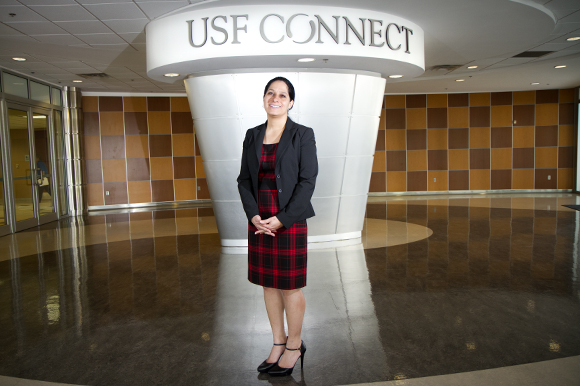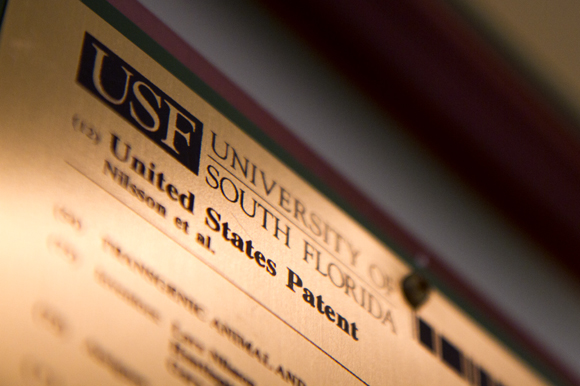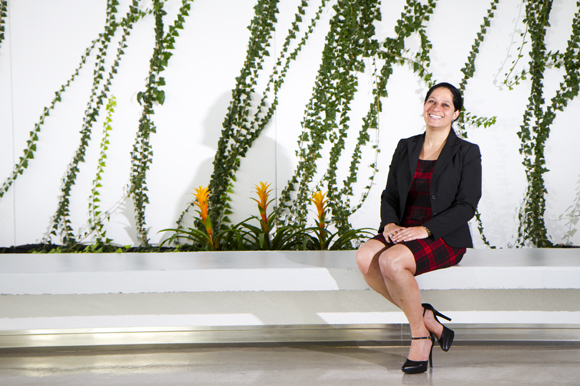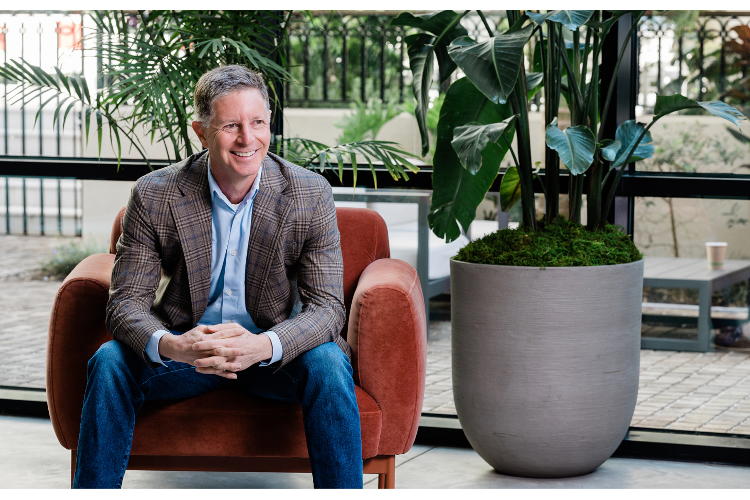USF Research Growth Rate: Among Top Universities
The breadth and depth of the scientific activities at the University of South Florida create huge opportunities for collaboration within the university, among other Florida colleges and universities and throughout the greater Tampa Bay community.
The University of South Florida is growing its research capacity at a torrid pace. From 2000 to 2007, no public institution received federal funding at a higher rate — a staggering 213 percent increase, according to the Chronicle of Higher Education Almanac.
In 2010, according to the Intellectual Property Owners Association, the investigative activities of USF students and faculty placed USF 9th among just 13 universities (and university systems) IN THE WORLD to be honored with the distinction of ranking within the top 300 patent-earning organizations.
USF was:
1. the only university in Florida to make the list;
2. the only ranked university in the Southeastern United States to make the list; and
3. behind only MIT for bragging rights on the entire US Eastern seaboard.
Not too shabby.
Interestingly, on its way to being awarded patent protection, every single one of those ideas had something in common: Each had landed on the desk of Valerie McDevitt, and passed through USF’s Technology Transfer Office: Division of Patents and Licensing.
A former chemist, McDevitt relocated to the Tampa Bay region to work for Bausch & Lomb. When they downsized, a brief stint at a law firm is all that stood between her and what would become her incredible decade at USF. That was 2002.
In describing what her team does, McDevitt explains: “We work hard to identify what makes the most business sense for each technology in the USF System research portfolio.”
Impressed by the investigative efforts of USF researchers, McDevitt continues: “When I first arrived, I hadn’t anticipated the breadth and depth of the scientific activities at a university of this size; there are huge opportunities for collaboration.”
For example, citing a strategic partnership with Draper Laboratories, McDevitt describes the efforts as capacity building, and an investment in establishing new relationships between investigators: “The science doesn’t always pan out, but the collaboration and the relationships have ways of turning into something interesting.”
And sometimes those “interesting,” anomaly-ish happenings result in scientific breakthrough(s). Isaac Asimov, the Boston University professor of biochemistry and unfathomably prolific science fiction writer (author/editor of more than 500 books and an estimated 90,000 letters and postcards), nails it with his famous line: “The most exciting phrase to hear in science, the one that heralds the most discoveries, is not “Eureka!’ (I found it!) but “Hmmm. That’s funny.’ ”
Systemized Serendipity
Given that USF is the 8th largest public university in the country, boasting more than 3,500 fulltime, part-time, and adjunct faculty, and more than 47,000 students, there is plenty of opportunity for this approach to systemized serendipity, there is also plenty of work to go around: “We’ve got a solid team of 16 fulltime employees and 10 student assistants who help out with filing and conducting prior art searches,” she says.
Facilitating the transfer of intellectual property from the metaphorical shelves of the Office of Research and Innovation to the marketplace involves the production of a customized, one-page document that conveys the value proposition of what are oftentimes hard-core, scientifically dense technologies. The trick is designing these to pique the interest of non-technical, potential suitors in the marketplace. To take this level of complexity and craft effective marketing messaging around technologies that may be early-stage and/or “ahead of their time” is not easy, and these guys have to be very good at it.
The charge also requires the team to understand more than science and intellectual property law. They must also be knowledgeable of the business side of the equation because any sort of deal structuring between the university and a third party involves valuating the technologies and negotiating win-wins for the university and its partners.
“It’s hard work, but it’s the best job in the world,” says McDevitt, “It’s high entertainment and high fulfillment. These are cutting-edge technologies with enormous potential to have an impact on people. If you think about it, the scientists are really excited about something new that they’ve discovered and we get to be the first stop for them!”
McDevitt’s eyes are now lit up, and her energy and passion fill the room as she begins to cite recent USF innovations that were supported by her team: a screening kit for ovarian cancer, an architecture student project for pre-wired, portable structures that can be deployed during disaster management events, and even liquid bandages for on-the-spot wound care.
The team did 35 licensing deals last year and is staying busy in 2012.
From Ohio State To USF
Providing the overall vision and leadership for the operation is Karen Holbrook, the former president of Ohio State University and current senior VP of Research, Innovation & Global Affairs.
“She gets it — the leadership aspect,” says McDevitt. “You need someone who can manage the pieces and drive this bus. She can. It makes an enormous difference; she sees things big, not small.”
Another example of USF placing emphasis on the act of invention and the transfer of those technological innovations outside of the institution is demonstrated by the fact that they are celebrating it more and more inside of the institution. Dr. Paul Sanberg, holder of 30 U.S. patents, has launched the National Academy of Inventors from within USF, and it serves to recognize patent holders and their work. Other universities can also sign up to become members, and that model has proven to be effective with more than 30 institutions having already created their own chapter.
There was a time when commercializing research was a dirty topic among the “pure” academicians. However, the economics of the situation have created a shift in culture in which moving the ideas into the marketplace, where they can be more useful to people, is getting more and more respect.
It also makes dollars and sense. The earnings come back to the institution as well as the researchers, and the university system benefits from the global awareness and positive brand affiliation that is achieved when a USF idea/product impacts humanity in a positive way.
Driving Economic Development
Also playing a significant role in this process is Rick Baker, a former St. Petersburg mayor and current VP of Economic Development for the USF System.
“Rick is a doer and a maestro. He sees something that is important to do and he gets it done. He’s been incredibly committed in terms of getting industry together with the university,” says McDevitt.
Speaking of collaboration, the pair — McDevitt and Baker — teamed up to land a significant economic relocation deal in 2011. McDevitt, recognizing that IRx Therapeutics had an expiring lease on their NYC real estate, reached out to Baker who invited the IRx leadership team to consider visiting Florida.
Company leaders were so impressed with the growth that the region had exhibited since they first moved north that, in a textbook case of relationships-driven economic development, the company ultimately decided to relocate back to Florida.
The governor held a news conference about the accomplishment at USF St. Petersburg, and the move earned McDevitt recognition from Tampa Bay Times business columnist Robert Trigaux, when he awarded McDevitt the ”Sharpest Eye in the Recruitment Game” award in his 2011 recap article.
The progress keeps unfolding, as Baker describes his role in the IRx deal and begins rattling off a host of other collaborations, strategic partnerships and potential deals currently in the works.
As BP oil flowed unfettered from the sea floor, Baker took the lead in acquiring funding — $10M right off the bat — to get boats and instrumentation into the water to figure out what was actually going on. From there, he rallied the necessary support from Florida’s governor and Congress to request permission for additional funding from BP. Since then, he’s helped bring in another $11M.
“We have local resources here of tremendous value. The rest is thinking up matches and chasing them down to make it happen,” says Baker. “I’m working in strategic partnerships, nonprofit, R&D partnerships and business partnerships,” he explains.
When asked to elaborate, he smiles, and says that he is excited for the future: “USF has a competitive advantage because we are in a major commercial center. However, it is only a competitive advantage if we exercise it. That means finding ways for businesses and the university to partner together to make both better.”
The wise eyes of the former mayor peer into a future-state that only he is privy to (yet) as he begins to rattle off a list of a dozen-or-so companies in a range of industries that he is working with. For example, he cites the continued relationship with Draper Labs, both the biotech presence on the USF Tampa campus, and the larger of the two facilities, in the St. Petersburg metro point area — a microelectronic manufacturing facility.
And then there is SRI, which is always doing interesting things. One current example in the local division is a digital mathematics teaching and learning innovation: SunBay mathematics. It’s a potential game changer and is on the radar of many STEM (Science, Technology, Engineering, and Mathematics) advocates. The next step likely involves a balance of legislative funding and private support to develop and launch it statewide.
In Terms Of Businesses
“I’m always working with businesses,” says Baker. “For example, Chromalloy, they make steel parts for blades for turbine engines. We’ve partnered them up with USF Engineering, and as a result, they’ve got five grad students as interns, and one full-timer (former student).”
Baker goes on to explain that it’s not just an instance of USF talent supporting the human capital needs of the business, but instead the company is contracting with USF around a specific research area: ceramic testing. The company has purchased the testing equipment and is housing it on campus and on top of that, they then pay students and faculty for ongoing research in the testing center.
It’s another example of creative thinking applied to the domain of university-driven economic development.
Nathan Schwagler is a freelance journalist, creativity researcher and visiting instructor of entrepreneurship at USF St. Petersburg who will buy you a cup of coffee or a delicious pint if you promise to tell him something interesting and on the record. Comments? Contact 83 Degrees.
















